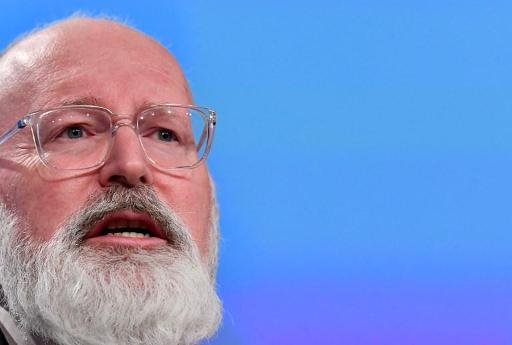BRUSSELS BEHIND THE SCENES
Weekly analysis and untold stories
With SAM MORGAN
Fit for 57?
Climate policies are ultimately all about maths, moving numbers about until you get the desired outcome. This week, the EU found an extra 2% of emission cuts down the back of the sofa. Could that small number prove to be bigger than it seems?
The EU’s current emissions-bashing goal for 2030 says the bloc has to cut greenhouse gases by 55%, as part of a longer journey towards ‘climate neutrality’ in 2050.
Controversially for some, it is a net goal, meaning that emissions can be balanced with carbon sinks like forests and peatlands. As new legislation governing those sinks was agreed recently, some extra ammo to help meet the 55% target was found.
Couple that with the EU’s landmark decision to ban emitting vehicles by 2035 and suddenly the climate accounts say that 57% is achievable. Every little helps, after all, but is this kind of incremental policymaking enough to meet our green needs?
BRUSSELS BEHIND THE SCENES is a weekly newsletter which brings the untold stories about the characters driving the policies affecting our lives. Analysis not found anywhere else, Sam Morgan helps you make sense of what is happening in Brussels. If you want to receive Brussels behind the scenes straight to your inbox every week, subscribe to the newsletter here.
The 2030 goal was much trickier to set than the 2050 net-zero benchmark, despite the fact the mid-century target is by far the more important, given that it is the final destination for much of the EU’s Green Deal.
Reasons for that are rather simple: the generation of political players that had to fight for net-zero will be, to put it delicately, out of the picture by the time that deadline expires.
It is also far enough in the future to pass under the radars of bad-faith actors, who would otherwise have attempted to lobby it into oblivion.
But 2030 is much closer. Less than a decade. Different percentages were bandied around when the target was being workshopped. 50%, 60%, 65% and so on. Eventually, governments and MEPs had to compromise on 55%.
That was the status quo until late last week when an agreement was struck on the EU’s updated land use regulation, known as LULUCF. The deal set a higher removal target of many more million tonnes of carbon, giving the EU even more scope to cut emissions.
Climate chief Frans Timmermans wasted no time in having the new numbers crunched and jetting off to COP27 in Egypt, where he told the rest of the world that the EU is exceeding its commitments and edging ever closer to a true green economy.
European Commission officials have to be given their dues. When they set out to write climate neutrality into law, many did not worry about the path needed to get to it, as the destination would define the journey toward it.
That logic is slowly being proved right, as the rules and regulations Brussels has proposed in the meanwhile have gradually ratcheted the 27-member bloc onto a trajectory needed to uphold its end of the Paris Agreement bargain.
It gives the EU extra ammo at international summits when confronting other big emitters about their climate commitments and strengthens their green diplomacy when it comes to linked issues like trade.
There is most certainly an argument to be made that these commitments do not live up to the EU’s historic contribution to climate change but that is a separate issue, one which is unlikely to be addressed anytime soon.
Turning numbers into results
57% is only a number for now. It needs to be formalised and then submitted to the UN as the EU’s new nationally determined contribution (NDC). Even then, it will just be a couple of digits on a piece of paper.
Translating it into action requires the governments of the bloc to enact policies. This week, the Commission wasted no time in issuing new guidance to national authorities about how to update their climate plans.
Those plans, or NECPs, need to be reviewed by June next year and need to reflect the 2030 goal, the REPowerEU strategy that aims to nix Russian fossil fuel imports and whatever comes out of the still-ongoing COP meeting.
Climate group CAN Europe calls NECPs “the single most important tool” when it comes to the EU’s green transition, adding that the process needs to be robust and transparent in order to get the most out of the clean economy.
There are two ways of looking at the coming process. Either governments draft plans that just about add up to 57% cuts, aided by a little financial massaging by the Commission and potentially some warnings about failing to do enough.
Or, the 27 member states commit to emission cuts, clean energy investment, building refurbs and mobility greening programmes that ultimately exceed the de facto 57% goal.
After all, 57%, just like the Paris Agreement’s 1.5 degrees warming benchmark, are not goals but limits. A lower and an upper limit, respectively. Anything above or below either number is the actual goal.
Brussels would be wise to impress that on its national partners over the course of the next couple of months. Finding cheeky percentage points here and there is all well and good but as time ticks away, big action is going to be needed.
BRUSSELS BEHIND THE SCENES is a weekly newsletter which brings the untold stories about the characters driving the policies affecting our lives. Analysis not found anywhere else, Sam Morgan helps you make sense of what is happening in Brussels. If you want to receive Brussels behind the scenes straight to your inbox every week, subscribe to the newsletter here.

